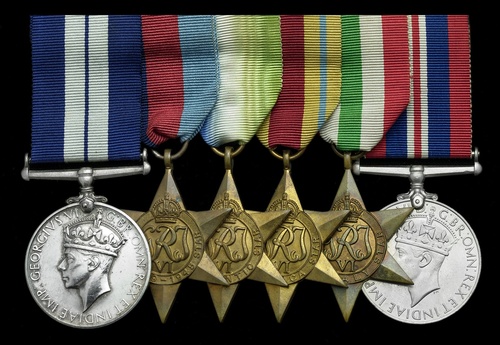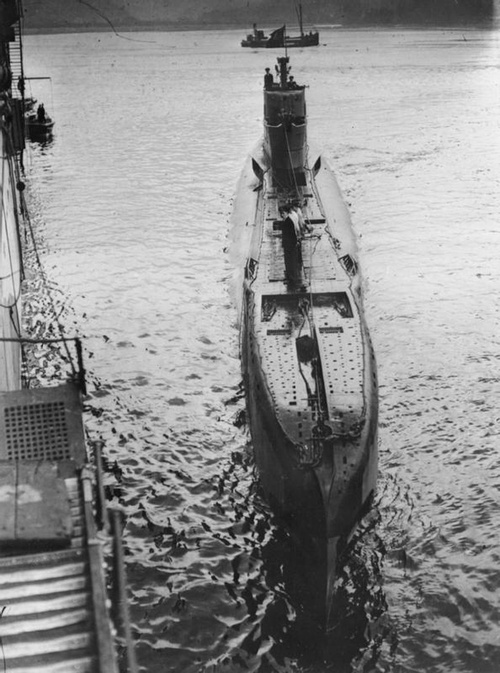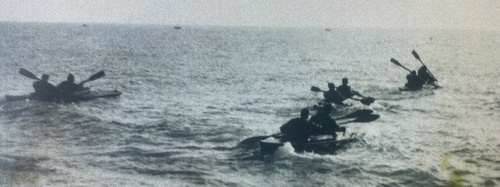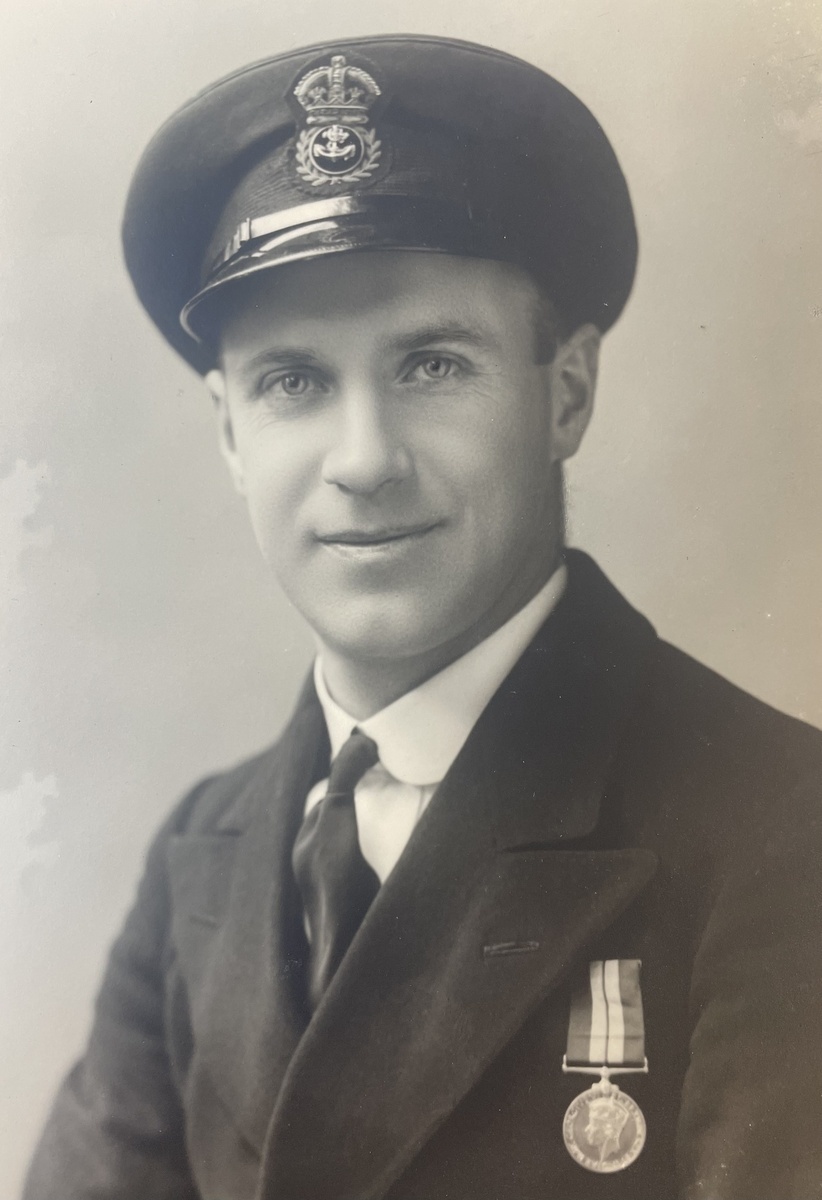Auction: 24003 - Orders, Decorations and Medals
Lot: 158
(x) A fine 1945 D.S.M. group of six awarded to Chief Engine Room Artificer L. G. J. Hayward, Royal Navy, a long-served submariner who shared in the famed actions of the Tuna
She carried out her fair share of special operations, most notably in December 1942, when she embarked and delivered the “Cockleshell Heroes” to the Gironde Estuary
Distinguished Service Medal, G.VI.R. (C.E.R.A. L. G. J. Hayward P/MX50132.); 1939-45 Star; Atlantic Star; Africa Star; Italy Star; War Medal 1939-45, good very fine (6)
D.S.M. London Gazette 19 June 1945.
Leslie George Joseph Hayward was born in Swindon, Wiltshire, on 6 March 1911. He was the second son of James Hayward, a carpenter employed by the Great Western Railway Company, and his wife Rose, who came from Teignmouth, Devon.
Hayward joined the Royal Navy on 10 October 1933 and volunteered for the submarine branch, being drafted to the Otway for training. She was an Odin-class submarine and had been built in 1926 for the Royal Australian Navy; in 1931, however, the Australians sold her to the Royal Navy.
By April 1939 Hayward took passage to the Far East in the British India liner Dunera and, on 25 May 1939, joined the Medway. She was the first ship to be purpose-built for the Royal Navy as a submarine depot ship. At 14,650 tons, she had a crew of 400 and could provide accommodation for another 1,350 men. She was depot ship for the 4th Submarine Flotilla on the China station. In September 1939 she proceeded to Singapore for a refit, and Hayward was attached to Tamar, the base at Hong Kong. In July 1940 he rejoined the Medway, which left on passage to the Mediterranean with her flotilla. For much of this time he served in the submarine Rover, a Rainbow class boat launched in 1930.
Hayward returned to the United Kingdom in September 1940 and was then drafted to the depot ship Forth at Holy Loch on the west coast of Scotland.
Fishy adventures - H.M.S. Tuna
He joined the company of the Tuna on 19 November 1940. She was a newly-completed T-class submarine with a displacement of 1,090 tons, a speed of 16 knots (surface) and 9 knots submerged, and an armament of ten torpedo tubes and one 4-inch deck gun. Her complement amounted to fifty-nine officers and men. Over the following two years he took part in a number of war patrols in the Bay of Biscay and off the Norwegian coast.
Tuna carried out her fourth war patrol in the Bay of Biscay between 12 December 1940-2 January 1941. At 0403 hours on the 18th she sighted the conning tower of a submarine. As the Usk was known to be in the area, Tuna flashed a challenge; the reply was unreadable and at 0430 she fired six torpedoes at the unknown submarine, which was in fact the Italian Brin. All missed, and Tuna then opened fire with her deck gun. The Brin made off with Tuna in pursuit. The Italian fired two torpedoes from her stern tube but they also missed. At 0523 the Brin was seen to be making her recognition signal to a surface ship which had come out to escort her in; Tuna turned away and dived. Two escort vessels then hunted her for some time but failed to make contact. Later that night, Tuna encountered an anti-submarine vessel and fired two torpedoes at it. Both missed and she then surfaced and fired nineteen shells. Five of them hit, leaving the ship on fire fore and aft and sinking. She was the Chassiron, a French tug under German control.
Tuna made her fifth war patrol off the Azores, finishing at Gibraltar without incident. She then escorted convoy HG54 before returning to Holy Loch. Between March-September 1941 she carried out four more patrols in the Bay of Biscay. Three were uneventful but the eighth patrol, in July, saw some excitement. On the 9 July Tuna strayed a short distance outside her area due to a navigation error and was attacked by a British aircraft, resulting in minor damage. The following day she detected a U-boat by Asdic and fired two torpedoes without result; she stalked the target for two hours and fired a third torpedo which also missed. However, enemy records indicate that there were no U-boats in the area - the contact must have been something else. On 19 July Tuna observed the enemy tanker Benno, escorted by four German minesweepers, and fired a spread of six torpedoes at a range of 6,000 yards. None found a target.
In mid-September the Tuna began a two-month refit. Hayward (who, in July 1941, had been rated acting Chief Engine Room Artificer) was briefly attached to the submarine P41 for liaison duty. This newly-completed 'U'-class submarine was transferred to the Norwegian Navy as the Uredd. Hayward returned to the Tuna on completion of the refit and took part in her tenth patrol which was uneventful.
On her eleventh patrol, she was tasked to act as a navigation beacon for the ships taking part in Operation Archery, a commando raid on Vaagsoy, on the coast of Norway. The following three patrols, one in the Bay of Biscay and two off the Norwegian coast, were all uneventful. On 4 April 1942 the Tuna left Holy Loch for Wallsend-on-Tyne, where she paid off and had a more thorough refit. Hayward was temporarily drafted to P43, later Unison.
Hayward rejoined the Tuna in September 1942 when she recommissioned on completion of the refit. She had a new commanding officer, Lieutenant Commander Dick Raikes DSO. He has been described as 'small of stature, with a thin face enlivened by eyes which had a permanent look of mischief about them and a mouth about which a smile always seemed to be hovering' (Ashdown refers).
He had a strong sense of humour and an even stronger dislike of bureaucracy. He was an experienced and formidable submariner who commanded an efficient and happy crew. On 23 October Tuna began her fifteenth war patrol off the coast of Norway. On this occasion she had two particular aims: to intercept the Admiral Scheer, believed to be on passage from the north of Norway to Germany, and to provide support for a Russia-bound convoy. She did not sight the pocket battleship but, in the early hours of 6 November, she detected an enemy submarine, U-625, and fired two salvoes of three torpedoes each. The U-boat changed course and all missed.
Operation Frankton
Hayward and his shipmates would have been aware that submarines were occasionally deployed to deliver or collect agents making clandestine trips to and from occupied Europe. However, they could have had little idea that their next patrol would be part of one of the most daring commando raids of the war - Operation Frankton.
Bordeaux lay seventy miles up the Gironde River and the Royal Navy considered that an amphibious raid in strength would require at least 20,000 men. A bombing attack was not possible on the grounds of difficulty in hitting the targets and the certainty of heavy civilian casualties.
In September 1942 the project was referred to Major H. G. 'Blondie' Hasler of the Royal Marines. Hasler was a canoeing enthusiast who, despite official scepticism, had obtained authorisation to set up a small canoe unit in Combined Operations. He personally designed a two-man canoe, known as the Cockle Mark II, which could be carried in a submarine, and recruited two officers and twenty-nine NCOs and men. Hasler drew up a plan for Frankton: a submarine would carry six canoes to the mouth of the Gironde, the canoes would paddle up the river over several nights, hiding themselves during the day, and attach limpet mines to the ships. The marines would then scuttle their canoes and escape overland to Spain. The plan was approved. Hasler selected twelve men from his section and they trained intensively over the month of October. None of them knew the nature of the mission and most suspected they were training for an attack on the Tirpitz.
Tuna was nominated to carry and deliver the raiders. She was a good choice - she had already carried out several patrols in the Bay of Biscay and in 1940 Raikes had landed agents on the coast near the Gironde. On returning from her patrol on 19 November, Tuna tied up near the Forth and Raikes was briefed about the operation by Captain Ionides, commanding the Flotilla. Tuna's role was summarised:
'To disembark the military party in a position from which they can proceed in their cockles to the mouth of the Gironde estuary approaching from the southwest. The whole operation is to be so conducted that the disembarkation is undetected by the enemy.'
The mission was a dangerous one for the submarine. The Germans fully appreciated the strategic importance of the Gironde; the area was protected by batteries of coastal artillery and anti-aircraft guns and patrolled by warships and aircraft, and there was a radar station. In addition, hundreds of French fishing boats fished there, and such boats sometimes carried German observers. Raikes later reported that at one time he had at least ten fishing boats within two miles of him, and dodging these boats was a major distraction. The seabed was very shallow along much of the Atlantic coast, with the shallow area extending for a considerable distance out to sea. Moreover, the currents and varying water densities as fresh water entered the sea made navigation difficult and unpredictable. One moment, the submarine would be stable with only the periscope above the surface, the next the vessel would suddenly seem much heavier and plunged towards the sea-bed. The water was heavy with plankton, resulting in a luminescent trail stirred up by their wake. Finally, the Royal Air Force had dropped many mines in the area. Raikes observed '...this plan quite evidently required extreme accuracy in navigation even allowing for the rather touching faith of the authorities in the accuracy of the positions given by the RAF - a faith which I did not share.'
Hasler and his twelve marines (including one spare man) embarked in the Tuna on the morning of 30 November. It was a grey, overcast day. The six canoes, or Cockles, were loaded through the submarine's forward torpedo hatch. They were all named after fishes: Catfish, Cuttlefish, Coalfish, Crayfish, Conger and Cachalot. Captain Ionides handed over Tuna's sailing orders, Hasler and Raikes went aboard and Tuna began her passage down the Firth of Forth to the sea. About an hour later, Hasler assembled his men and briefed them on the operation. The initial reaction was relief that they were not going up against the Tirpitz. He invited anyone who was uncomfortable with the mission to withdraw - none did.
Tuna called in at Helensburgh, further down the Clyde, for degausing, a process to remove her magnetic signature. Whilst still in Scottish coastal waters they practised the launch procedure; the submarine surfaced, the canoes were brought up and laid out on the casing, lifting slings were attached to the gun and, one by one, the canoes were hoisted up, swung out over the side and lowered to the sea.
The passage was an unpleasant one for the marines. The wind had freshened to force 5 and, when on the surface, she pitched and rolled violently, inducing seasickness. When she submerged, her movement was smoother but the atmosphere was stale and pervaded by the nauseating stench of bilge-water and diesel. Smoking was, of course, out of the question. Space in the forward compartment was extremely cramped and some suffered from a degree of claustrophobia. Tuna's sailors did what they could to ease their discomfort - unknown to Hasler, some even saved their precious rum ration in medicine bottles and gave it to their guests.
At dawn on 8 December, Tuna dived about sixty miles south-west of Finisterre and proceeded down the Bay of Biscay, about eighty miles offshore. She surfaced after dark and sometimes had to alter course to avoid fishing boats under sail. She arrived about sixty miles off the mouth of the Gironde at dusk on the 4th. The wind had dropped and the sea was flat calm, apart from the long Atlantic swell. There was an alarm shortly after midnight when engine noises were heard astern, and from time to time aircraft were heard overhead. She submerged at dawn on the 5th, and approached closer to the coast, frequently zigzagging to avoid fishing fleets. When she surfaced at dusk she was about thirty miles offshore, and sixty from the Pointe de Grave. During that day Hasler gave another briefing to his men, emphasizing that if any boats became separated they should carry on alone. Several of the marines wrote their last letters home.
Tuna continued her approach during the night of 5/6 December. As before, she dived at dawn. Tension was now very high; they were close to a large minefield. and more aircraft flew overhead, including maritime patrol sea-planes. As before, they frequently had to alter course to avoid fishing boats. In the afternoon, the marines prepared their Cockles for disembarking. However, Raikes had been unable to fix his location accurately - the weather was hazy and the coastline flat and featureless. With a great sense of anti-climax the marines restowed their equipment and resigned themselves to another day of waiting.
Tuna spent the early hours of 7 December lying silent and motionless on the surface, rocking gently in the swell. There was no moon but the stars glittered brightly in the pitch black sky. Just before dawn Raikes was able to get a good star fix, and in the early afternoon he observed the lighthouse at the mouth of the Gironde, enabling him to fix his position with precision. This was essential as he crept up towards the mouth of the river with a minefield to port and the enemy coast to starboard. Tuna's log recorded 'intense air activity' and they continued to encounter fishing boats. There was total silence aboard as the hydrophone operator listened carefully, assessing the type and distance of other vessels when propellor noises were detected. At one point something metallic bumped down their port side and they tensed for the mine explosion which would send them all to eternity, but nothing happened. The marines prepared the Cockles and changed into the special clothing they would wear for the operation.
At 1800 the asdic operator reported propellor noises, identified as a diesel-powered ship about eight miles away. Tuna stopped her engines and Raikes observed through the periscope a German patrol boat at the mouth of the Gironde. Soon all could hear the repeated 'ping' as the patrol boat's sonar probed the depths. The submarine submerged to seventy feet and waited. The patrol boat remained in the area where Raikes had intended to launch the canoes, and he had to approach much closer to the shore, away from the main channel of the estuary.
Tuna surfaced at 1930 hrs to find a calm sea. The night was clear and very cold, and the thunder of the surf breaking on the beach two miles away could be heard. One lookout kept his binoculars trained on the patrol boat, still only two and a half miles away, a second lookout scanned the horizon for any other threats. The slings were rigged on Tuna's gun and the canoes were brought up and ranged on the casing. One of them, the Cachalot, was ripped by the locking clasp of the forward hatch and, to the despair of her two crewmen, Raikes ordered it to be returned below. Then, as the first canoes were being lowered into the sea, German searchlights on the Pointe de Grave suddenly lit up and began sweeping the estuary. By turning her stern to the patrol boat to reduce her visual profile, Tuna had turned side-on to the German radar station at the mouth of the Gironde and maximised her electronic profile. The radar detected her but she was far enough away to remain unseen and the Germans assumed that the contact was a stray fishing boat. Disembarking the five canoes took forty-six minutes. Hasler gave a hand signal and the canoes formed an arrowhead formation and paddled off towards the Gironde. Raikes waved a farewell to 'a magnificent bunch of black-faced villains with whom it has been a real pleasure to work'.
Still on the surface, Tuna restarted her main engine and set a course for the south-west. She had a difficult passage home. The weather was atrocious, Raikes was unable to navigate and had to rely on dead-reckoning. When Raikes estimated that they were near England, he sent an officer to the conning tower with a sextant to take a fix; the officer spent five hours before obtaining a fix on an unclear horizon. The submarine then altered course, just in time to avoid running aground on the Lizard. She arrived in Plymouth on the evening of 13 December.
A couple of hours after launching, the canoes encountered very turbulent water caused by tidal rips. Only four canoes emerged from the maelstrom - Coalfish was not seen again. A short distance further on there was a second overfall with waves up to five feet high. Conger capsized; her two crew members hung on to the sterns of other boats for nearly an hour, then attempted to swim to shore. Shortly before dawn, Cuttlefish became separated from the other two, leaving Hasler with only one third of his original force.
Catfish and Crayfish continued the operation as planned, paddling upstream during the night and hiding during the day. They were observed by local people but not betrayed. Cuttlefish continued on her own but struck an underwater obstruction and sank shortly before reaching Bordeaux. On the night of 12/13 December they entered the port of Bordeaux and attached limpet mines to the sides of nine ships. The two teams then scuttled their Cockles, separated, and set off to reach Spain. Hasler and his partner reached Ruffec, where they fortuitously made contact with the Resistance. They were smuggled into Spain and eventually reached England. They were the only ones to survive. Conger's crew succumbed to cold and drowned. The other six marines were all captured by the Germans and executed in accordance with Hitler's 'Commando Order'. They had written their names into history as the Cockleshell Heroes and Hayward had certainly played his part.
Hayward left the submarine on 23 March 1943 and was first drafted to the Forth as spare crew. He joined the Unswerving in May 1943 and would have shared in the events when she sunk the German gunboats GN61 & GN62 in the Skiathos Channel, six sailing vessels and the tanker Bertha. He went up to Buckingham Palace to receive his D.S.M. from the hands of The King on 23 October 1945, was discharged in January 1946, he died in Liverpool in September 1977.
Subject to 5% tax on Hammer Price in addition to 20% VAT on Buyer’s Premium.
Sold for
£1,300
Starting price
£1200













